Dive deep into the world of the crypto bubble with with us. Explore the dynamics of cryptocurrency markets, understand the speculative trends, and gain insights into what drives the volatility and growth in the digital currency sphere. Perfect for investors, enthusiasts, and financial analysts.
The Cryptocurrency Bubble: Is It Popping?
Cryptocurrency is often considered the wild frontier of finance. Since the inception of Bitcoin in 2009, it has simultaneously captivated and confounded the world of finance and money: from Wall Street to Main Street. It's a volatile virtual asset punctuated over the past 15 years by dizzying spikes and crushing plunges. And every time it rises, it has fueled debates about a bubble waiting to burst. But within this volatile landscape, there are vital trends and dynamics worth analyzing as a means to understanding the future of crypto.
The Current Crypto Bubble in 2024
From a purely technical standpoint, crypto -- led by Bitcoin -- has had an impressive bull run leading into 2024. From its lows in the $16000s at the turn of 2023, Bitcoin has risen to highs near $49000 in early January 2024. That's more than double in a year.
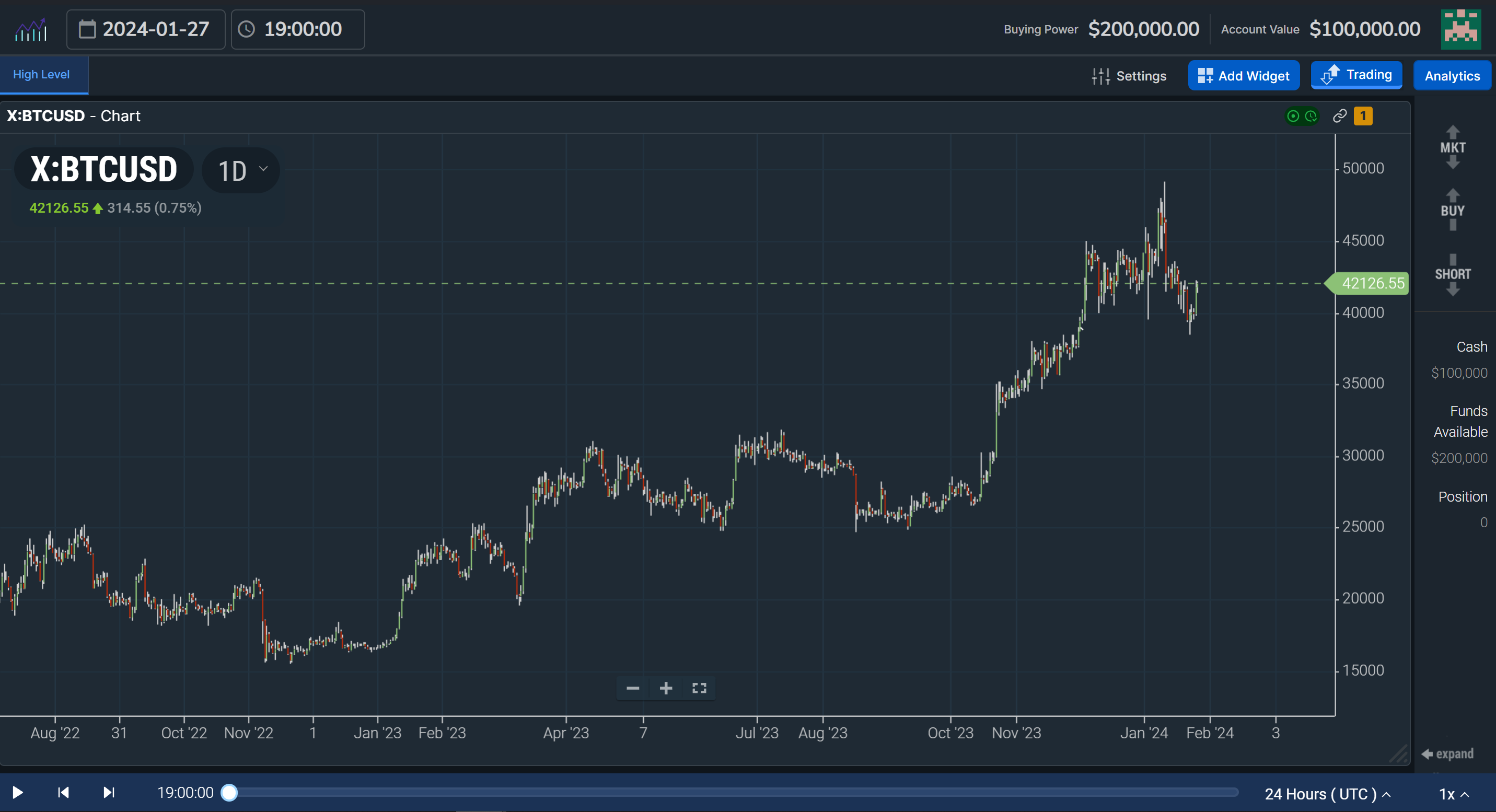
As you can see, there is a lot of volatile ups and downs in this process. However, the movement off the lows of the start of 2023 have been impressive. The question that many investors are probably asking is whether or not this is just another bubble inflating and waiting to be popped.
One thing you should consider is the underlying meta-analysis of key levels. If you've followed crypto for any length of time, you know that from lows of the Covid crash in 2019 to the highs of 2021, there was a frenzy to buy bitcoin. Keep in mind that a lot of these investors invested on that meteoric rise. As such, they've been "underwater" in their investment for much of 2022 and 2023, waiting for it to rise again.
Let's pan out and take a look at the bigger picture of the past 3-4 years:
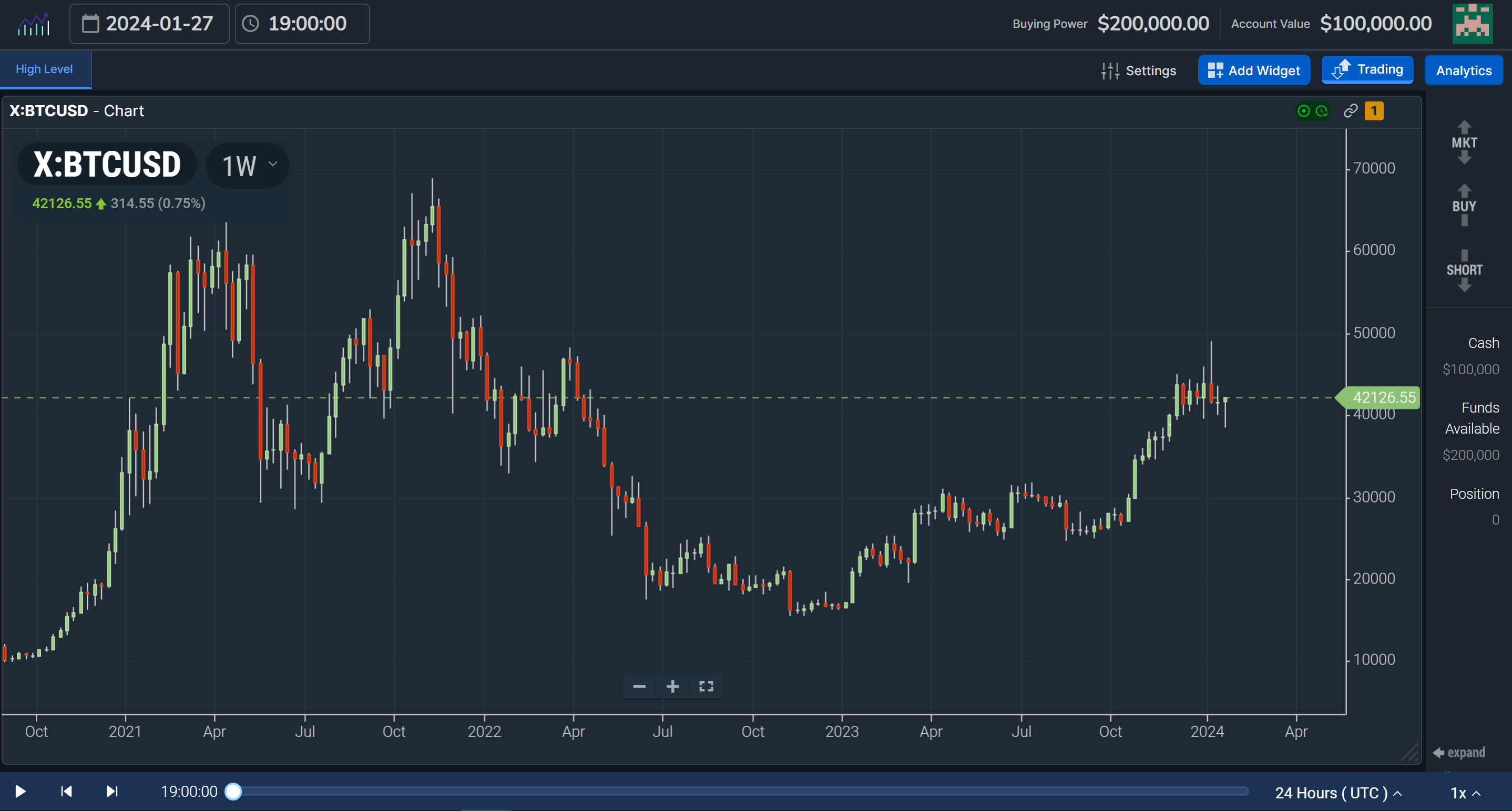
What you see on a broader time frame is a rally in Bitcoin back into the congestion of the 2021-2022 consolidation at all-time highs. Many of the investors who bought in at these prices are just now breaking even again. On that token, one must consider whether these investors are cashing in now that they are back to break even or if they are willing to hold for higher gains.
Will the Bitcoin ETF Affect the Price of Bitcoin?
Another important matter in the current crypto bubble is the approval of an ETF for Bitcoin. Just moments after this approval on January 11 by the U.S. Securities and Exchange Commission (SEC) the price of Bitcoin plummeted. From the highs of $49102, BTC dropped a whopping $10,000 in a very short time.
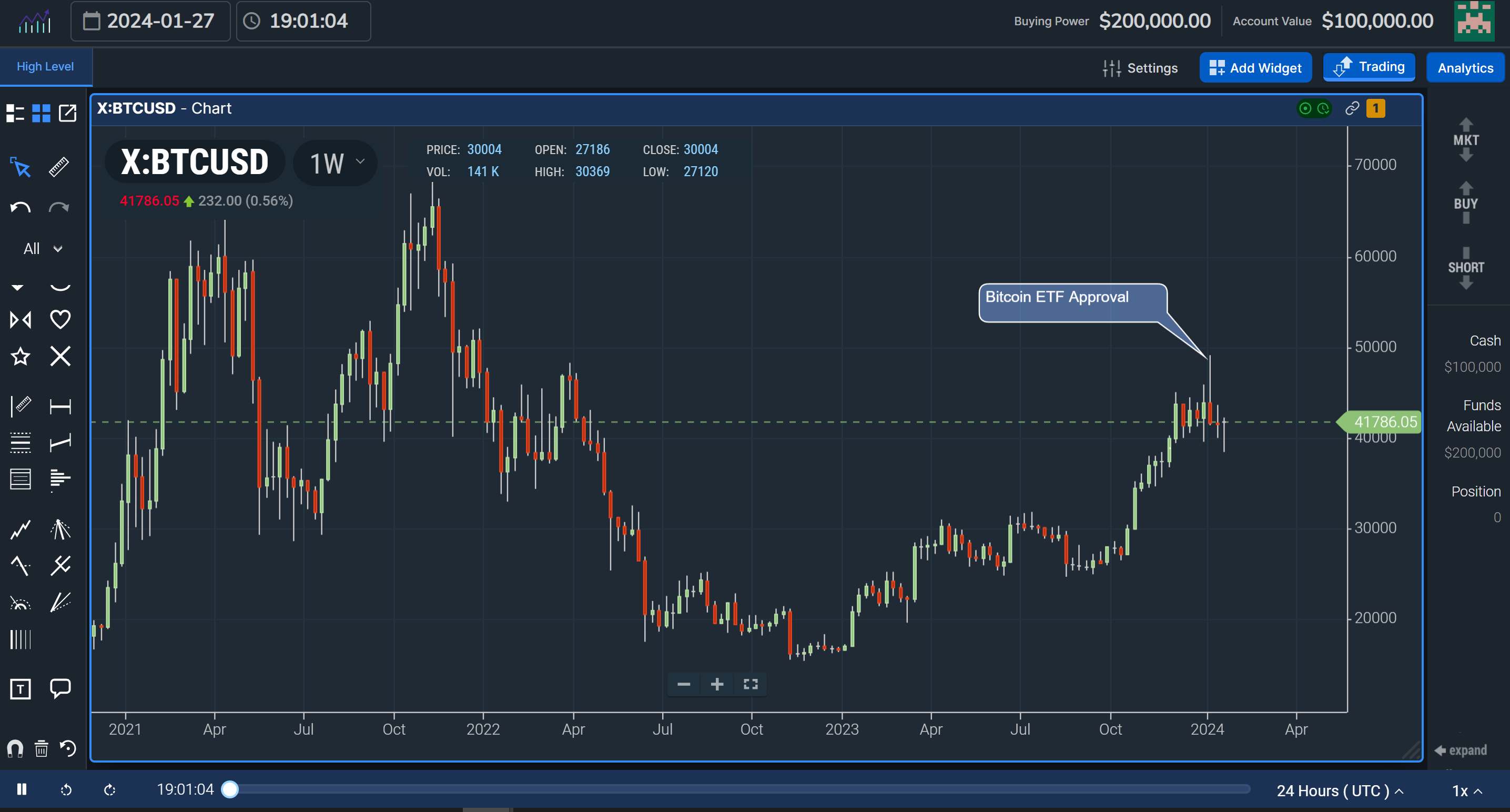
The question investors may have is whether or not this will lead to further selling, or if it was simply a temporary "sell the news" event for Bitcoin. As noted by Louis Sykes of AllStarCharts, Bitcoin tends to sell off after newsworthy events and financial launches. It is yet to be determined whether this will be the case for BTC on the new ETH approval.
Blockchain Market Trends
The underlying technology of the crypto world, blockchain, continues to evolve, with applications beyond just virtual currencies. From supply chain management to healthcare data security, blockchain's potential to reshape industries is undeniable. Understanding these trends is crucial for discerning the long-term potential beyond the cryptocurrency hype.
From Web3 and DeFi to NFTs and enterprise adoption, the applications of this transformative technology are rapidly expanding. Let's dive into some of the hottest trends reshaping the blockchain market in 2024:
1. The Rise of Web3
Web3, the vision of a decentralized internet powered by blockchain, is gaining serious traction. Imagine owning your data, controlling your online identity, and interacting with platforms in a peer-to-peer fashion. That's the promise of Web3, and it's attracting both individual users and major tech companies.
2. Decentralized Finance (DeFi) Takes Center Stage
DeFi is revolutionizing traditional finance by offering access to financial services without intermediaries. Lending, borrowing, trading, and even insurance are all being reimagined on blockchain platforms, empowering individuals and challenging the status quo of the financial system.
3. NFTs Beyond the Collectibles Craze
While the hype surrounding NFT collectibles might have cooled down, the underlying technology holds immense potential. NFTs are being used for everything from fractionalizing real estate to authenticating luxury goods and powering loyalty programs. Expect to see more innovative use cases emerge in the coming years.
4. Enterprise Blockchain Adoption
Businesses are waking up to the power of blockchain. From streamlining supply chains to enhancing transparency and security, blockchain is finding its way into various industries like healthcare, logistics, and even government services.
5. Sustainability Takes Root
The energy consumption of some blockchain networks has raised concerns about their environmental impact. However, new consensus mechanisms and green initiatives are emerging to address these concerns, paving the way for more sustainable blockchain solutions.
6. Regulatory Landscape Evolves
Governments are scrambling to regulate the rapidly growing blockchain space. While some regulations might pose challenges, clear guidelines can also bring much-needed stability and attract institutional investment.
7. Interoperability Makes Strides
One of the biggest hurdles to mass blockchain adoption is the lack of interoperability between different networks. However, cross-chain bridges and interoperable protocols are being developed to break down these silos and foster a more connected blockchain ecosystem.
8. Talent Wars Heat Up
As the demand for blockchain expertise skyrockets, a fierce talent war is brewing. Developers, engineers, and specialists with blockchain knowledge are in high demand, with salaries and benefits reaching competitive levels.
Educating the public and businesses about blockchain technology is crucial for wider adoption. Initiatives like online courses, educational workshops, and industry collaborations are playing a vital role in bridging the knowledge gap.
While the future of blockchain remains uncertain, one thing is clear: decentralization is here to stay. The blockchain market is rapidly evolving, and its impact on various industries will continue to grow in the years to come.
Digital Currency Speculation
A major driver of the crypto market, especially during boom times, is pure speculation. The promise of quick profits lures investors, pushing prices to unsustainable levels. Separating hype from genuine value proposition is key to making informed investment decisions.
As we saw in the massive bull market from 2019-2021, many investors piled into crypto assets like NFTs, Bitcoin, and other blockchain-based issues. Those exorbitant prices and exuberance eventually led to a massive selloff and devaluation in 2022.
This volatility makes speculation in this emerging market incredibly tempting, but also fraught with risk. So, before you jump on the crypto bandwagon, let's take a closer look at the exciting, yet precarious, world of digital currency speculation.
The Allure of the Crypto Boom
Let's face it, the stories of overnight millionaires made from Bitcoin and other early crypto adopters are hard to resist. The potential for massive gains is undoubtedly a major driver of speculation in this market. Early investors in Bitcoin, for example, saw their holdings rise from mere pennies to tens of thousands of dollars, creating a gold rush mentality among newcomers.
This speculative frenzy is often fueled by factors like:
- Technological innovation: The underlying blockchain technology behind digital currencies offers a glimpse into a decentralized future, attracting tech enthusiasts and forward-thinking investors.
- Limited supply: Many digital currencies, like Bitcoin, have a capped supply, creating a sense of scarcity and driving up demand.
- Influencer hype: Social media influencers' sunny forecasts of record-breaking prices and celebrity endorsements can create a bandwagon effect, attracting even more speculators.

The Looming Bust
However, it's crucial to remember that speculation is a double-edged sword. While it can lead to immense profits, it can also result in devastating losses. The extreme volatility of digital currencies makes them incredibly risky investments. Prices can swing wildly based on factors like regulatory crackdowns, negative news cycles, and even Elon Musk's tweets.
Here are some of the risks associated with digital currency speculation:
- High volatility: Be prepared for the market to move against you quickly and unexpectedly.
- Lack of regulation: The nascent nature of the market means there are fewer safeguards against fraud and scams.
- Technological challenges: Blockchain technology is still evolving, and there are risks associated with hacking and technical glitches.
- Limited understanding: Many speculators lack a deep understanding of the underlying technology and the risks involved.
Speculate Responsibly
If you're considering venturing into the world of digital currency speculation, proceed with extreme caution. Do your research: Understand the specific digital currency you're considering investing in, its underlying technology, and the associated risks. Here are some more tips for you to consider:
- Invest only what you can afford to lose: Remember, speculation is inherently risky, and you could lose your entire investment.
- Diversify your portfolio: Don't put all your eggs in one basket. Spread your investments across different digital currencies and asset classes.
- Stay informed: Keep up with the latest news and developments in the digital currency market.
- Don't get caught up in the hype: Remember, not all that glitters is gold. Be wary of get-rich-quick schemes and unrealistic promises.
Ultimately, digital currency speculation is a high-risk, high-reward game. While the potential for significant gains is real, the risks of losing your entire investment are equally real. Before you take the plunge, make sure you have a clear understanding of the market, a well-defined investment strategy, and a healthy dose of risk tolerance.
Crypto Investment Analysis: Do's and Don'ts
As a compliment to your speculative efforts, we recommend a thorough analysis before any real money is put in play. Understanding factors like tokenomics, project goals, and team expertise can help navigate the minefield of risky scams and identify promising ventures.
In addition, good old technical analysis is essential to making good investments in Crypto. In other words, learn when to buy and when not to buy. Buying at the top of a meteoric rise in prices in Bitcoin is probably going to lead you to massive losses in subsequent years.
Diversifying of your portfolio, doing your own research, and setting risk management parameters are imperative to a successful crypto investment.
Here are some additional tips:
- Consider using a dollar-cost averaging (DCA) strategy. This involves investing a fixed amount of money into a cryptocurrency at regular intervals, regardless of the price. This can help you to average out the cost of your investment over time.
- Be careful about leverage. Leverage can amplify your gains, but it can also amplify your losses. Be careful about using leverage, and only use it if you understand the risks involved.
-
- Store your cryptocurrencies in a secure wallet. There are many different types of wallets available, so do your research to choose one that is right for you.
Bitcoin Market Dynamics
As the undisputed king of crypto, Bitcoin sets the tone for the entire market. Its price fluctuations have a ripple effect, impacting smaller currencies. Analyzing Bitcoin's technical indicators and understanding its correlation with traditional markets can provide valuable insights.
Bitcoin's market dynamics are complex and influenced by a multitude of factors, but here's a concise breakdown:
Supply and Demand
- Limited supply: Bitcoin has a capped supply of 21 million. This scarcity can drive up prices as demand increases.
- New bitcoins are introduced slowly: Mining rewards halve roughly every four years, further reducing the rate at which new bitcoins enter circulation.
- Demand: Driven by various factors like investor sentiment, institutional adoption, and perceived value of bitcoin as a store of value or hedge against inflation.
Market Psychology
- Volatility: Bitcoin is notoriously volatile, with rapid price swings driven by news, hype, and uncertainty.
- FOMO (Fear of missing out) and FUD (Fear, uncertainty, and doubt): These emotions can quickly sway market sentiment, leading to sudden buying or selling sprees.
- Technical analysis: Traders use charts and indicators to identify potential trends and predict price movements.
External Influences
- Regulation: Government regulations and crackdowns can impact confidence in the market and affect price.
- Traditional markets: Correlation with traditional financial markets can influence bitcoin's price.
- Technological advancements: Innovations in blockchain technology or competitor cryptocurrencies can affect Bitcoin's dominance.
Additional factors:
- Media coverage: Positive or negative news can influence public perception and demand.
- Whales: Large holders with significant bitcoin holdings can impact the market through their selling or buying decisions.
- Adoption by businesses and institutions: Increased adoption can boost trust and demand, driving up the price.
Understanding Bitcoin's market dynamics requires ongoing research and analysis. While the profit potential is high, so are the risks, and responsible investing is crucial.
Cryptocurrency Volatility
Rapid price swings are the norm in cryptocurrencies, making it a high-risk, high-reward game. Understanding your risk tolerance and having a solid exit strategy are crucial for avoiding emotional investing during turbulent times. Just look at a chart of Bitcoin. Can you sit through these price fluctuations? Think about the emotions it would conjure during a 70-90% correction.
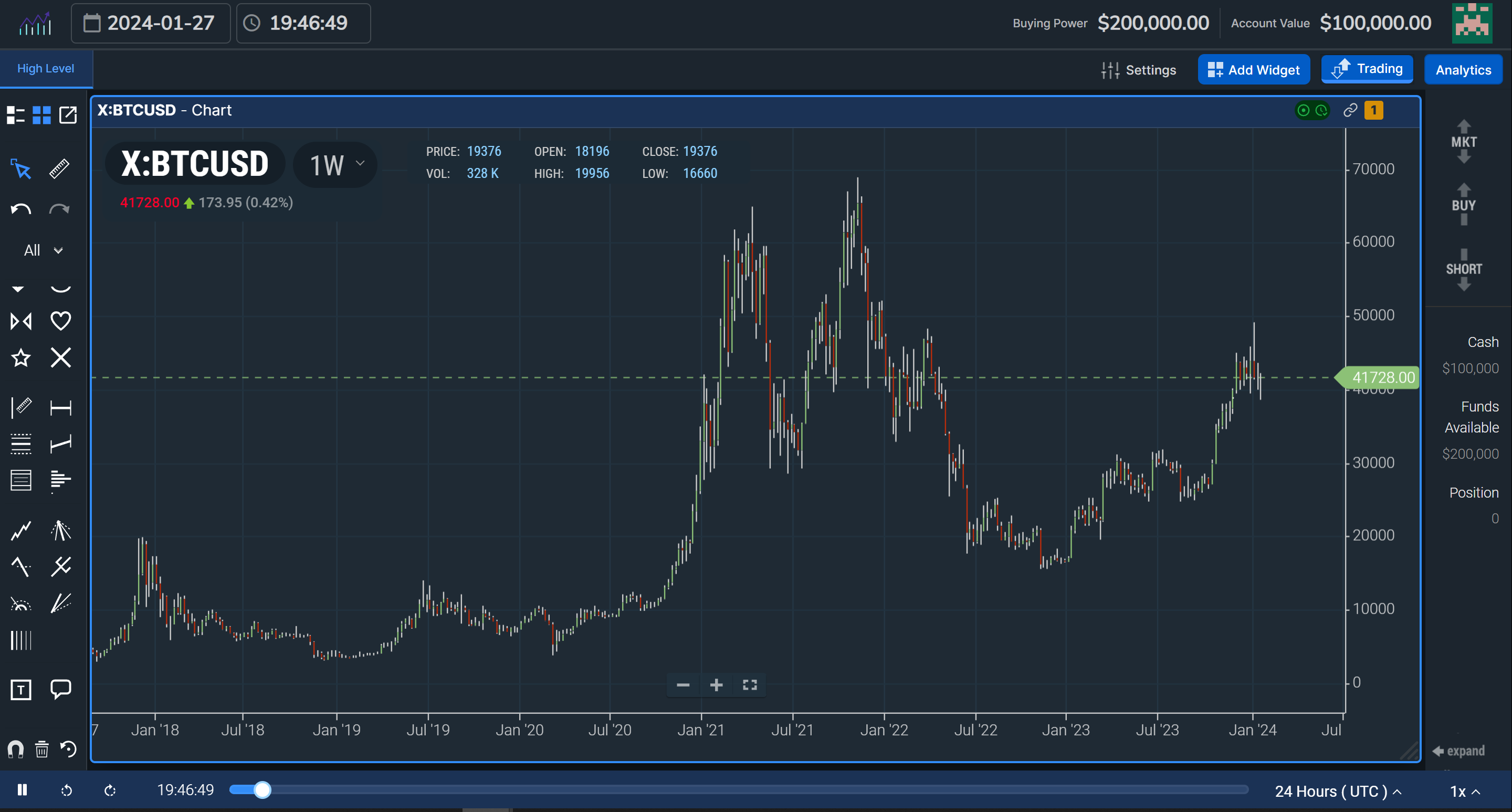
Ethereum Price Fluctuations
While Bitcoin reigns supreme, Ethereum, the smart contract king, is the second major player in the crypto world. Its price movements, often influenced by the development of decentralized applications (dApps) on its platform, offer a different perspective on the market.
Ethereum's value has always been its ability to write secure contracts based on the blockchain technology it provides as a medium. However, Bitcoin is quickly gaining influence in this area of interest based on Stacks (STX). STX is a blockchain network that allows smart contracts to be written through dApps on the Bitcoin network. It is also open-sourced. The difference is that ETH contracts start from scratch on a programmable blockchain, whereas STX writes its contracts into a programmable BTC base layer.
Digital Asset Trading
With numerous exchanges and trading platforms, navigating the complex world of digital asset trading can be overwhelming. Understanding different order types, fees, and security protocols is essential for making informed trades and safeguarding your crypto holdings.
If you are considering getting involved in digital asset trading, it is important to do your research and understand the risks involved. You should also only invest what you can afford to lose.
Here are some additional things to keep in mind:
- Choose a reputable exchange: There are several digital asset exchanges available. It is important to choose a reputable exchange that has a good track record of security and customer service.
- Store your digital assets securely: Once you have purchased digital assets, it is important to store them securely. You can do this by using a hardware wallet or a reputable cryptocurrency exchange.
-
- Don't invest more than you can afford to lose: As mentioned above, digital assets can be very volatile. It is important to only invest what you can afford to lose.
Crypto Market Forecast
Predicting the future of any market is a fool's errand, but analyzing data and expert opinions can offer a glimpse into potential scenarios. Be wary of bold pronouncements and remember, the future of crypto is still being written.
Instead of making predictions, we recommend studying market and technical analysis, then trying out your strategies in our crypto simulator.
Blockchain Economic Impact
Beyond the speculative frenzy, blockchain technology has the potential to revolutionize entire industries. Understanding its potential economic impact, from decentralizing finance to boosting transparency in supply chains, is crucial for assessing its long-term significance.
The cryptocurrency bubble may have deflated from its 2020 highs, but the underlying innovation of blockchain remains. By separating hype from reality, conducting thorough analysis, and keeping a level head, investors can navigate the volatile but potentially transformative world of digital currencies. For many, the future of finance appears to be decentralized, and those who understand the dynamics of this digital revolution stand to reap the rewards.

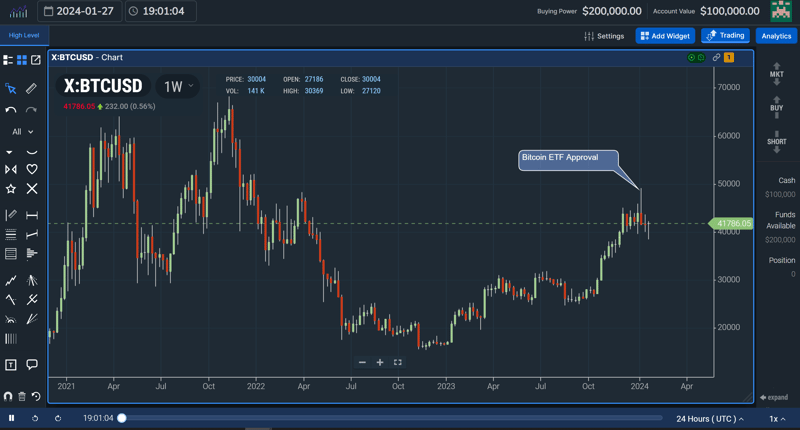










 Crypto
Crypto 
